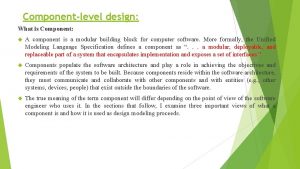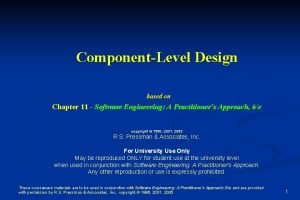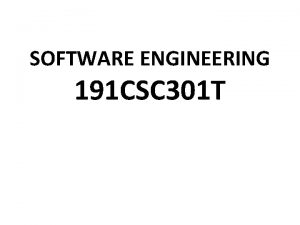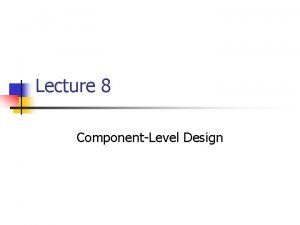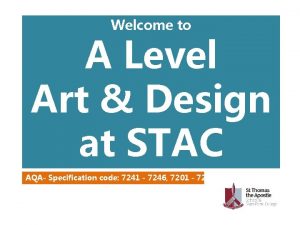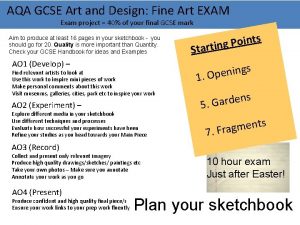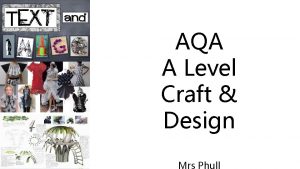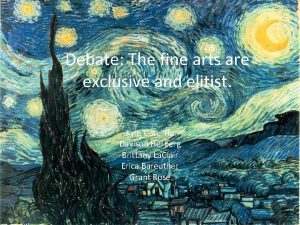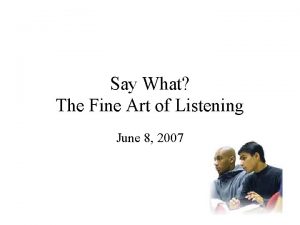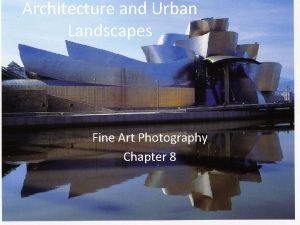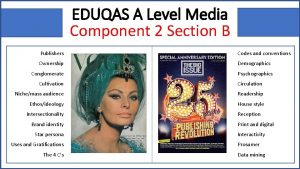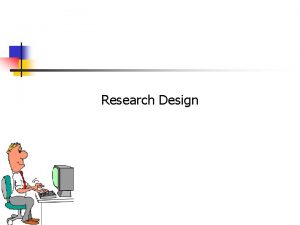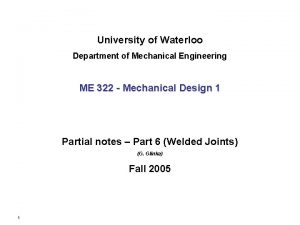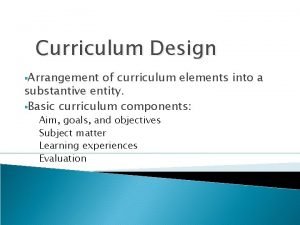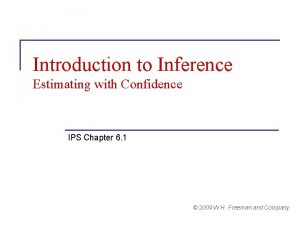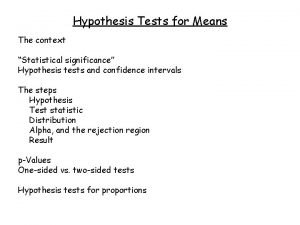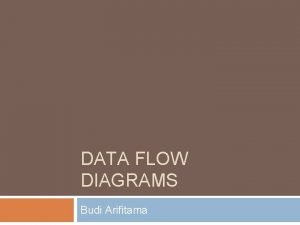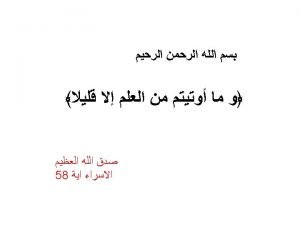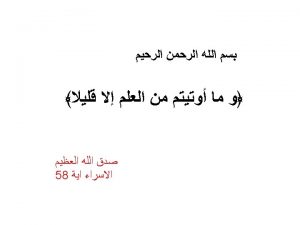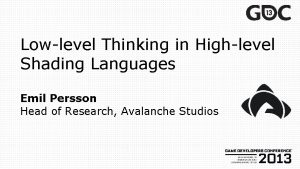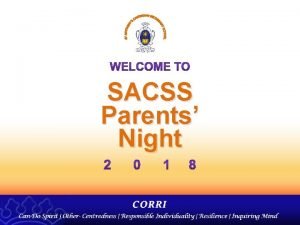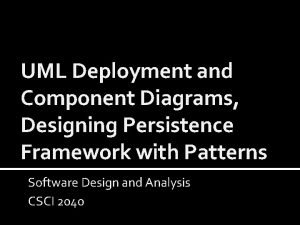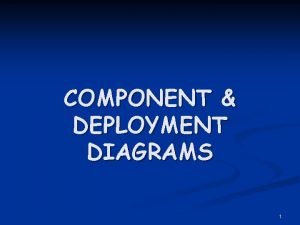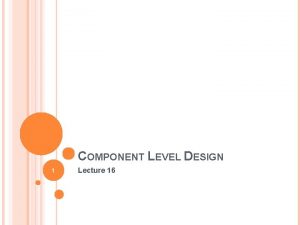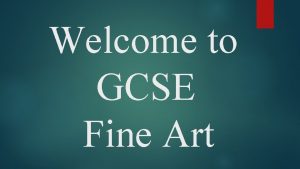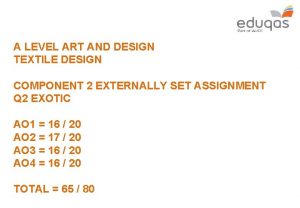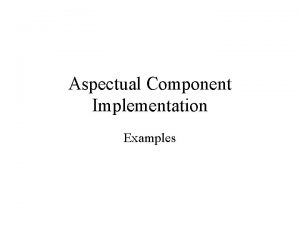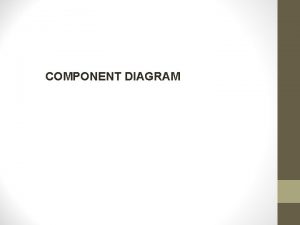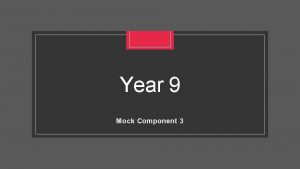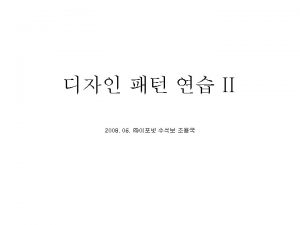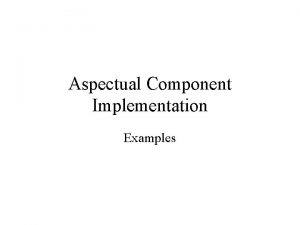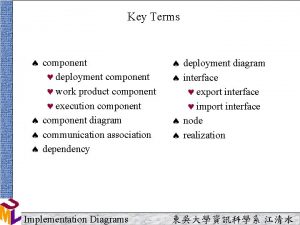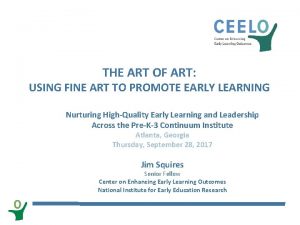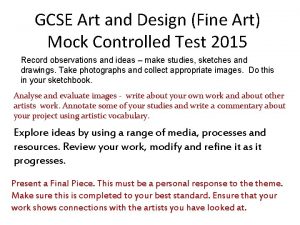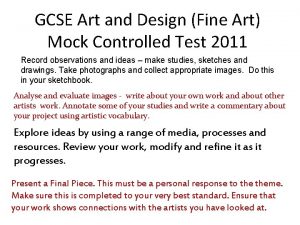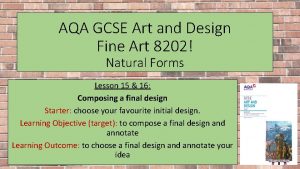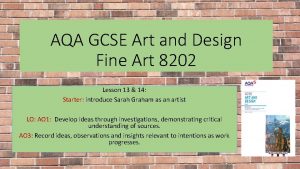A LEVEL ART AND DESIGN FINE ART COMPONENT




































- Slides: 36

A LEVEL ART AND DESIGN FINE ART COMPONENT 2 EXTERNALLY SET ASSIGNMENT AO 1 = 10 / 20 AO 2 = 9 / 20 AO 3 = 9 / 20 AO 4 = 9 / 20 TOTAL = 37 / 80

A LEVEL ART AND DESIGN FINE ART UNIT 3 EXTERNALLY SET ASSIGNMENT AO 1 = 13 / 25 AO 2 = 11 / 25 AO 3 = 11 / 25 AO 4 = 11 / 25 TOTAL = 46 / 100

SAFON UWCH CELF A DYLUNIO CELFYDDYD GAIN UNED 3 ASEINIAD WEDI'I OSOD YN ALLANOL AA 1 = 13 / 25 AA 2 = 11 / 25 AA 3 = 11 / 25 AA 4 = 11 / 25 CYFANSWM = 46 / 100

































The assignment chosen by the candidate is Time Worn. The main ideas identified for development are: ‘things that change or look different over a long period of time’. An interest in creating work by ‘working over the top of already time worn surfaces, such as wood and rusted metal’, is also noted. AO 1 A sequence of reasonably developed ideas is generally sustained, although there is very little evidence of incremental learning. A range of appropriate source material is documented, though largely in the form of artist references rather than other types of related contextual material. These are accompanied by written evaluation rather than critical analysis. In this respect, instead of simply describing references, written dialogue to convey deeper meaning as well as understanding of purposes and contexts, would have been beneficial. AO 2 There is evidence of suitable media and processes being employed, such as relief-printmaking techniques, however, despite a degree of exploration, the visual qualities found in these observational studies are not investigated rigorously. These works would have undoubtedly benefited from greater control of technique as well as further investigation of the creative potential of the materials and processes. Working methods are reviewed but repeated, often without obvious purpose. In addition, studies lack attention to detail and careful refinement which has resulted in unresolved outcomes. The relationships between these approaches are rarely made and the penultimate stage of development is seemingly not documented. AO 3 Observations are made and demonstrate ability to record from relevant sources in relation to intentions. Digital photography of close up sections of worn and weathered surfaces are used as a method of logging visual qualities. A reasonable amount of research and enquiry can be seen, however, this could have been further enriched by engaging judicious reflection and review as work unfolded. AO 4 Personal interests and responses are presented, with intentions realised in a satisfactory way. There is evidence of connections being made between visual, written, oral and other elements, but not always in a convincing way. Investigation of differing compositional and presentational formats is not seen and it would certainly have been beneficial to explore these prior to arriving at the realised outcome.
 Component level design example
Component level design example Component-level design in software engineering
Component-level design in software engineering Transform mapping in software engineering
Transform mapping in software engineering Component-level design example
Component-level design example Aqa a level art and design
Aqa a level art and design Art gcse aqa
Art gcse aqa Art and design a level aqa
Art and design a level aqa Hegel aesthetics lectures on fine art
Hegel aesthetics lectures on fine art Is debate a fine art
Is debate a fine art Listening is a fine art
Listening is a fine art Fine art photography architecture
Fine art photography architecture A level media component 2
A level media component 2 Observed demand formula
Observed demand formula Meaning of research design
Meaning of research design Mechanical engineering uwaterloo
Mechanical engineering uwaterloo Arrangement of the elements of curriculum
Arrangement of the elements of curriculum How to interpret confidence intervals example
How to interpret confidence intervals example Significance level and confidence level
Significance level and confidence level Confidence level and significance level
Confidence level and significance level Bus garage repair dfd
Bus garage repair dfd Health and social care component 3 health and wellbeing
Health and social care component 3 health and wellbeing Difference between fine touch and crude touch
Difference between fine touch and crude touch Crude touch
Crude touch Waterfall vs shower approach
Waterfall vs shower approach Molecular level vs cellular level
Molecular level vs cellular level Isis protocol
Isis protocol Isis level 1 vs level 2
Isis level 1 vs level 2 Piramida level keamanan informasi memiliki berapa level
Piramida level keamanan informasi memiliki berapa level Examples of costa's level 1 questions
Examples of costa's level 1 questions Thread level parallelism in computer architecture
Thread level parallelism in computer architecture Rcp hlsl
Rcp hlsl Poly foundation programme
Poly foundation programme What are the inputs and outputs of system design
What are the inputs and outputs of system design Deployment diagram vs component diagram
Deployment diagram vs component diagram Composite and component knowledge ofsted
Composite and component knowledge ofsted Component in deployment diagram
Component in deployment diagram Btec
Btec
